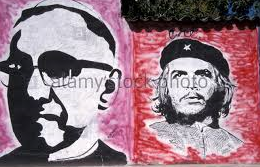
Who Is Oscar Romero and Why Should We Care?
I recall my surprise when I first went to El Salvador and at community or church events saw huge photos of Che Guevara next to ones of similar size of Oscar Romero.
Guevara was an Argentinian doctor who joined the Cuban revolution. He later tried to start a revolution of his own in Bolivia and was killed in 1967 by the Bolivian military. He became a symbol of armed revolution in Latin America and much of the world, his face appearing on the front of millions of t-shirts.
Romero was the Archbishop of San Salvador, the capital of El Salvador. He was a champion of the Salvadoran poor and defender of human rights against a brutal government, not an advocate of violence. Nonetheless, he was assassinated in 1980 while celebrating Mass by elements of the Salvadoran military.
The shock was seeing those two, a militaristic revolutionary and a Catholic member of the hierarchy, side-by-side. The Catholic hierarchy is not known for being revolutionary. To many minds, in fact, it is considered among the most conservative of institutions. Yet here were images of the two side-by-side.
Still a Hero
I was in El Salvador recently and 37 years after his death, Romero is still a national and religious hero to much of the population. Each year on the anniversary of his death, a Catholic mass is held at the small hospital chapel where he was shot followed by a march to the city’s center.
What do Romero and Guevara have in common? They both gave their lives for a cause, the liberation of an oppressed people. Guevara believed the best way to liberation is in armed revolt. Romero believed in the power of persuasion and the power of God to influence world events.
In fact, Romero – as could be expected of a religious leader – was more interested in the spiritual than in the poor’s physical hardships, although he believed the two were intertwined.
Interestingly, the military and oligarchs who ruled El Salvador when Romero was appointed archbishop were happy with the choice, seeing in him a defender of the status quo. That changed a few weeks after Romero’s appointment when Salvadoran security forces shot and killed Father Rotilio Grande, one of the new archbishop’s best friends.
Romero was deeply affected and receiving no satisfactory explanations from the government for Grande’s murder, took up Grande’s causes of defense of the El Salvador’s poor against continual arbitrary and illegal persecution by the government.
The background to all this was the fact that everything in the country was stacked in favor of the oligarchy and the military that supported them. Grande and Romero saw this not only as a political problem but a religious one. Those persecuting the poor were mostly Catholics who were ignoring Christ’s message and it was Grande’s and Romero’s duty to defend the poor, speak out against their persecution and seek the conversion of their persecutors.
They were influenced by the documents of a conference of Catholic bishops held in Medellin, Colombia, in 1968.
Conversion
“The uniqueness of the Christian message,” says one of its documents, “does not so much consist in the affirmation of the necessity for structural change, as it does in an insistence on the conversion of men and women which will in turn bring about this change.”
The oligarchy and military didn’t buy this message and in the 12-year civil war that raged between 1980 and 1992 over 60,000 Salvadorans would die. Like Romero and Grande, many of them were Christians – lay people, priests and nuns – whose only crime was working with the poor.
Like most human beings, people searching for God need models – others who have made personal sacrifices to continue their search and help others along the way. No better models could be found than Romero, Grande and the thousands of martyrs of El Salvador, courageous seekers of peace.
“Peace,” wrote Romero, “is not the product of terror or fear. Peace is not the silence of cemeteries. Peace is not the silent result of violent repression. Peace is the generous, tranquil contribution of all to the good of all. Peace is dynamism. Peace is generosity. It is right and it is duty.”


